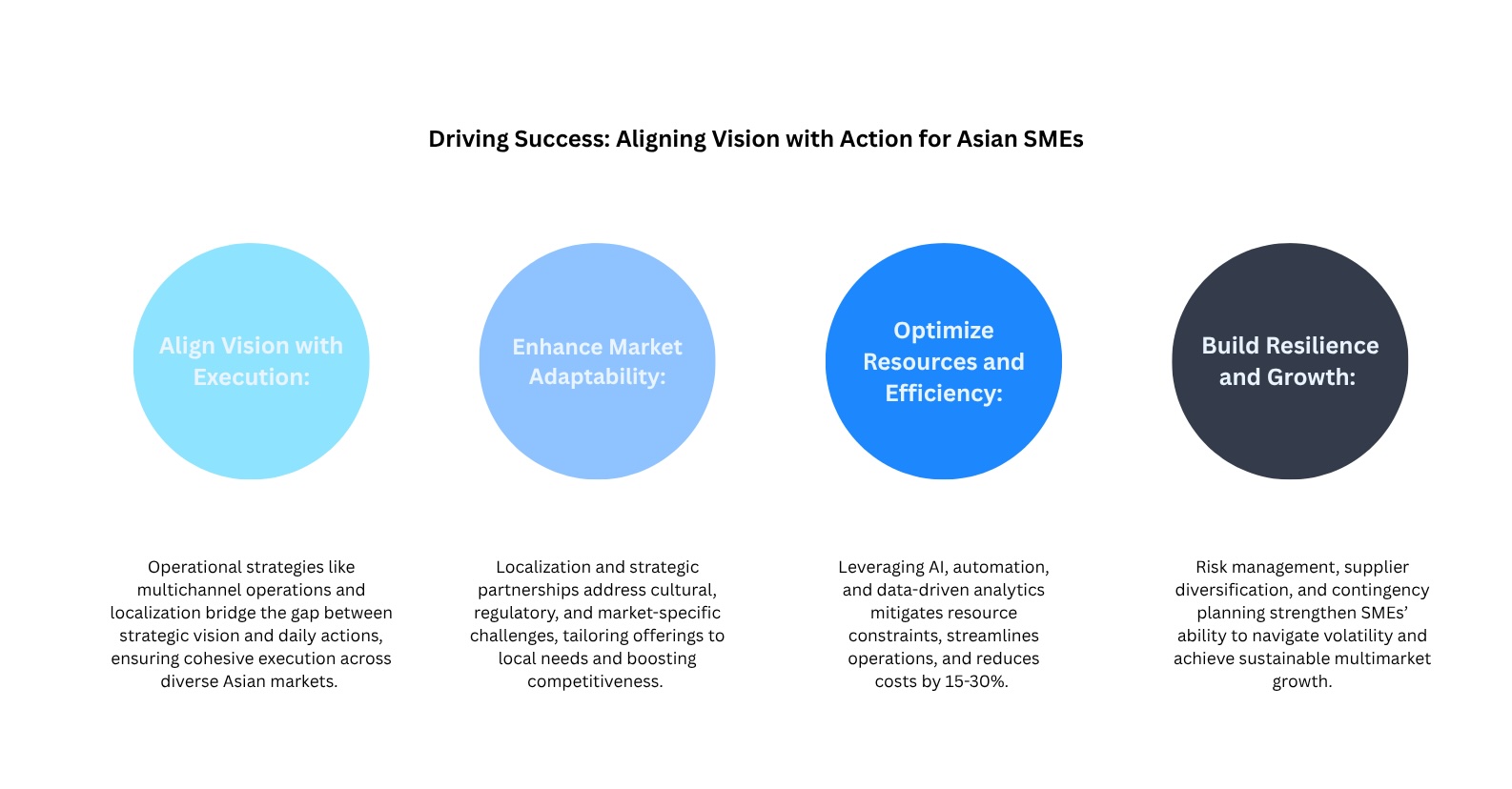Discover operational strategies for Asian SMEs, including multichannel operations and localization, to align vision with execution.
Operating a business in Asia can be challenging! In the dynamic and competitive landscape of small and medium-sized enterprises (SMEs), operational strategy plays a pivotal role in ensuring the alignment and execution of strategic priorities. For SMEs operating in Asia's diverse and rapidly evolving multimarket environment, harmonizing Vision with action is necessary and a competitive advantage.
Today, let us explore the operational strategies SMEs in Asia can adopt to align their strategic priorities with effective execution, leverage the unique opportunities, and overcome the challenges of operating in a multi-market context.
The Importance of Operational Strategy in SMEs
The operational strategy serves as the bridge between an SME's Vision and its day-to-day activities. It ensures that strategic priorities are translated into actionable plans that drive growth, efficiency, and resilience. To thrive in Asia's multimarket environment, Leaders must adopt robust operational strategies that align strategic priorities—digital transformation, market diversification, sustainability, and innovation—with practical execution. These strategies directly address the unique challenges of Asian market expansion, including diverse market dynamics, regulatory complexities, resource constraints, and cultural and technological gaps (Exports News, 2019; Lexology, 2025).
Let's assess how integrating technology, partnerships, and localized approaches can enhance SMEs' resilience, competitiveness, and profitability.
Effective Operational Strategy
To thrive in Asia's multimarket environment, SMEs must adopt operational strategies that ensure alignment with their strategic priorities. Below are key strategies that SMEs can implement:
Multichannel Operations
Multichannel operations enable SMEs to diversify revenue streams, reduce market-specific risks, and cater to Asia's diverse buyer behaviors (Exports News, 2019). The Xentral Business Barometer Report notes that SMEs balancing online and offline channels achieve 20% higher growth (E-commerce Germany News, 2025).
- Online Channels: According to a 2024 ASEAN report, B2B e-commerce platforms (e.g., Alibaba.com) and affiliate networks (revenue-share models) account for 30% of regional B2B transactions. These platforms address diverse market dynamics by targeting niche industries, such as manufacturing in Vietnam or tech in Singapore.
- Offline Channels: Trade shows (e.g., Singapore's CommunicAsia) and direct client engagements build trust in markets like Japan, where 60% of B2B buyers value face-to-face interactions, per a 2024 study, overcoming cultural gaps.
- Integration: Combining online lead generation with offline relationship-building ensures flexibility. According to a 2023 ASEAN report, 25% of SMEs reported improved client retention.
Localization of Operations
Localization aligns B2B offerings with local client needs and regulatory frameworks, addressing diverse market dynamics and regulatory complexities (Exports News, 2019; Lexology, 2025).
- Adapting Services: Customizing solutions to local market needs adapts solutions towards new potential clients. For example, a recent 2024 study found that SME boosted contracts by 12% by localizing ERP software.
- Hiring Local Talent: Local employees may be required based on licencing, regulatory, or corporate governance requirements. Further, local talent can bridge cultural gaps by understanding negotiation styles, e.g., relationship-driven in Thailand versus efficiency-focused in Singapore.
- Local Partnerships: Collaborating with regional distributors ensures compliance with trade agreements like RCEP, streamlining operations, and providing expanded reach into new client segments.
Leveraging Technology and Automation
Technology mitigates resource constraints and technological gaps, enabling scalability (Harris Sliwoski LLP, 2025).
- Digital Transformation: According to Gadgets Magazine (2025), AI-powered CRM and supply chain tools cut operational costs by 15-20%. Manual tasks are systemised and embedded within core processes to enhance client management.
- Automation: Automating lead qualification and invoicing enhances efficiency, particularly in markets with lower digital adoption like Myanmar, where 15% of SMEs adopted basic automation, per a 2024 ASEAN report (E-commerce Germany News, 2025).
- Scalable Solutions: Cloud-based platforms, used by 25% of SMEs, reduce infrastructure costs by 30%, enabling expansion without heavy investment, per a 2023 ASEAN study.
Data-Driven Decision Making
Data analytics optimizes client targeting and operational efficiency, addressing diverse market dynamics and resource constraints. Predictive analytics, adopted by 5% of SMEs, forecasts market demand and identifies growth opportunities, per the IDC Blog (2024).
- Client Insights: Analytics on B2B e-commerce platforms reveal buyer preferences, with 20% of SMEs adjusting offerings, per a 2024 ASEAN report.
- Resource Allocation: BI tools optimize budgets, with 15% of SMEs reducing marketing waste by 10%.
- Risk Mitigation: Predictive models anticipate supply chain disruptions, enhancing resilience in volatile markets like Indonesia.
Strategic Partnerships and Alliances
Partnerships with local tech providers, distributors, and industry associations overcome resource constraints and regulatory complexities (Harris Sliwoski LLP, 2025; Lexology, 2025).
- Market Access: Collaborations with affiliate networks increase leads by 10-15%, per Dun & Bradstreet (2022). A Singapore SME partnered with a TradeIndia affiliate, boosting exports by 18%.
- Collaborative Innovation: As noted in the Journal of Business Economics (2023), co-developing B2B solutions tailors products to regional needs, e.g., IoT solutions for Malaysia's manufacturing sector.
- Regulatory Support: Regional alliances, like ASEAN Business Networks, streamline RCEP compliance, benefiting 20% of SMEs, per a 2024 study.
Risk Management and Resilience
Robust risk frameworks address regulatory complexities and economic volatility, ensuring continuity (Lexology, 2025).
- Supplier Diversification: Sourcing from multiple countries (e.g., Vietnam and Thailand) mitigates disruptions, with 25% of SMEs maintaining operations during 2024 supply chain issues, per a 2024 ASEAN report.
- Financial Reserves: According to a 2023 study, maintaining 3-6 months of reserves, as 15% of SMEs do, supports resilience.
- Contingency Plans: According to a 2024 ASEAN study, business continuity plans, adopted by 20% of SMEs, ensure rapid recovery from cyberattacks.
Addressing Market Expansion Challenges in Asia
Operating in Asia's diverse markets presents Leaders with unique challenges that operational strategies effectively address:
- Diverse Market Dynamics: Be clear on target markets and aware of distinct buyer behaviors and competitive landscapes. Multichannel operations (e.g., direct-to-client portals for tech firms) and localization strategy (e.g., tailored solutions) ensure local relevance.
- Regulatory Complexities: Get detailed local advice as varying tax laws, differing regulatory environments, and trade laws make expansion difficult if not understood and included within operational strategy (Lexology, 2025). Strategic partnerships and local advisory streamline compliance, mitigate risk, and improve entry effectiveness.
- Resource Constraints: Limited budgets challenge scalability, and stretched resource capacity impacts effectiveness (Harris Sliwoski LLP, 2025). Offshoring and nearshoring, combined with automation and phased approaches, optimize resource time and capabilities and improve launch performance.
- Cultural and Technological Gaps: Markets like China embrace e-commerce, while others lag (E-commerce Germany News, 2025). Training programs and affiliate networks adapt to these gaps, with improved client engagement through localized digital strategies, per a 2024 study.
In Summary
In Asia's multimarket landscape, SMEs need effective operational strategies that align Vision and Mission with action in an operational context. Multichannel operations are complex; however, Businesses can harmonize their Vision with actionable plans by adopting multichannel operations, localizing their approach, leveraging technology, and forming strategic partnerships. Furthermore, integrating sustainability and data-driven decision-making into their operations will enable SMEs to build resilience and unlock growth opportunities.
As Asia continues to evolve as a global economic powerhouse, SMEs that align their strategic priorities with effective operational strategies will survive and thrive.


